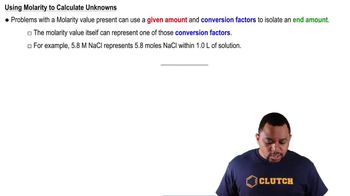Here are the essential concepts you must grasp in order to answer the question correctly.
Molarity
Molarity is a measure of concentration defined as the number of moles of solute per liter of solution. It is commonly expressed in units of mol/L. To convert grams of a substance to moles, one must use the molar mass of the substance, which is the mass of one mole of that substance in grams.
Recommended video:
Molar Mass of Gold
The molar mass of gold (Au) is approximately 197 g/mol. This value is essential for converting the mass of gold in grams to moles, which is necessary for expressing concentration in mol/L. Knowing the molar mass allows for accurate calculations when dealing with solutions and concentrations in chemistry.
Recommended video:
Unit Conversion
Unit conversion is the process of converting a quantity expressed in one set of units to another set of units. In this context, it involves converting the concentration of gold from grams per milliliter (g/mL) to moles per liter (mol/L). This requires understanding the relationship between grams, moles, and liters, as well as applying appropriate conversion factors.
Recommended video:
 Verified step by step guidance
Verified step by step guidance


